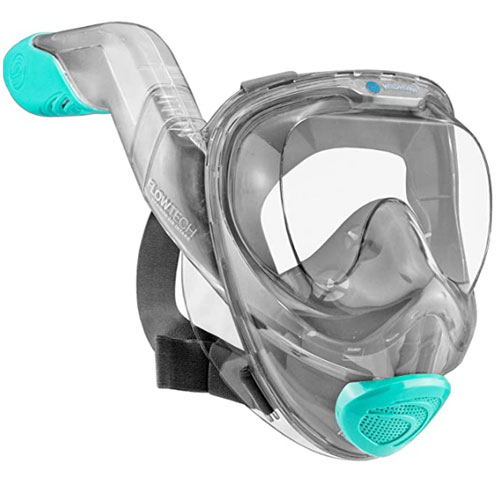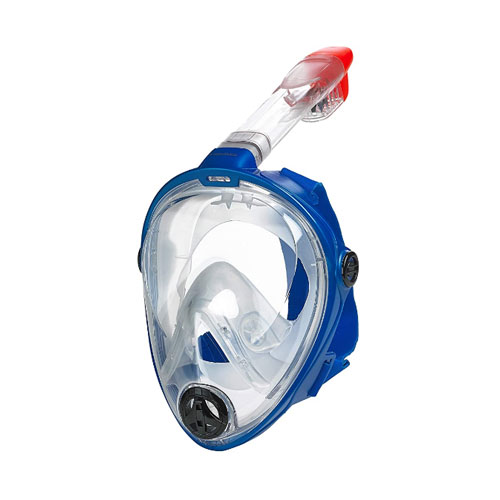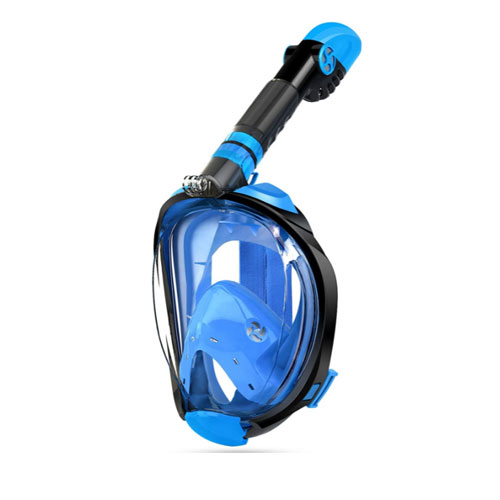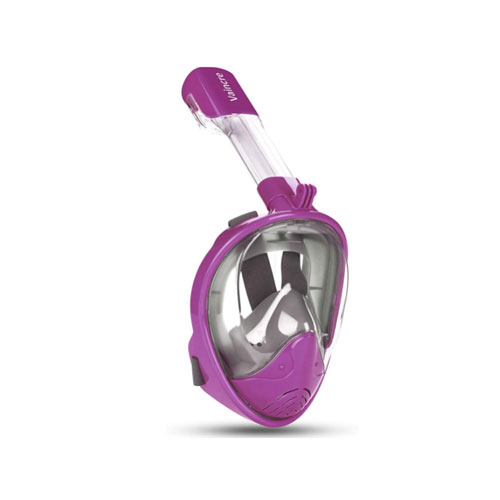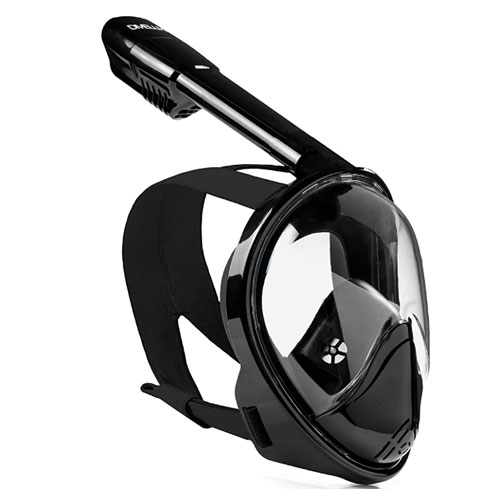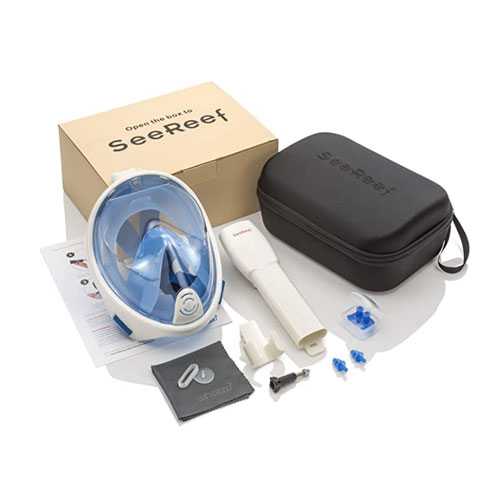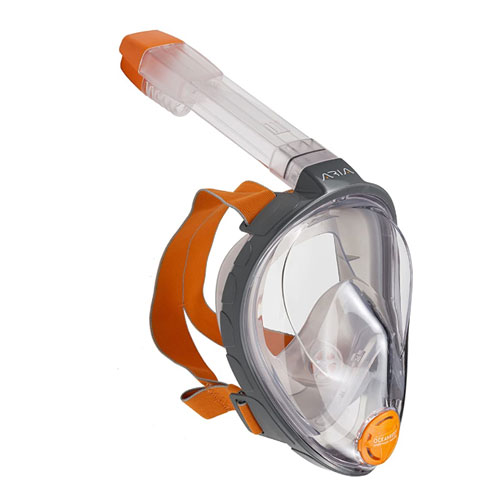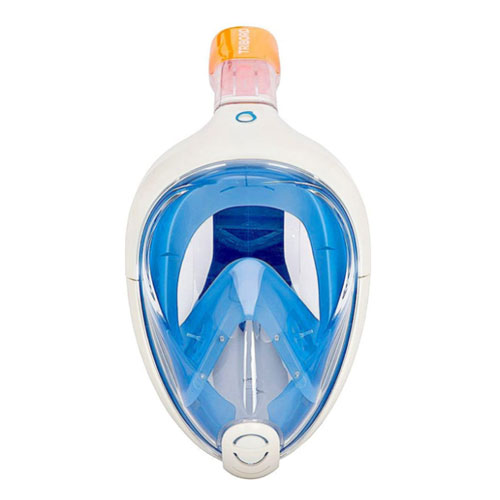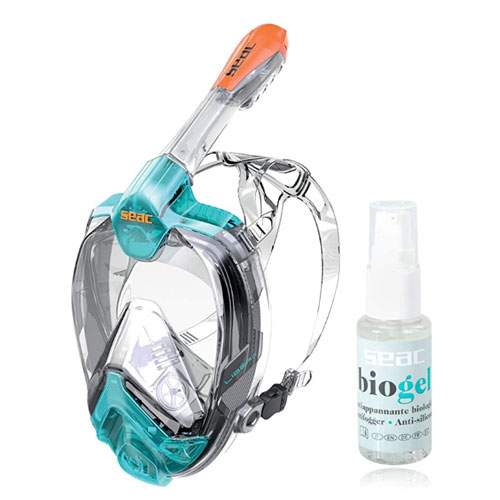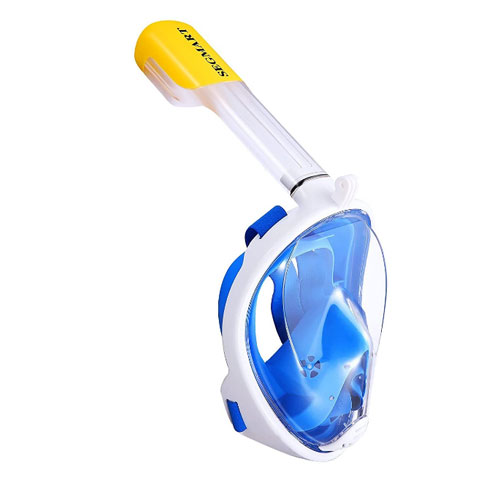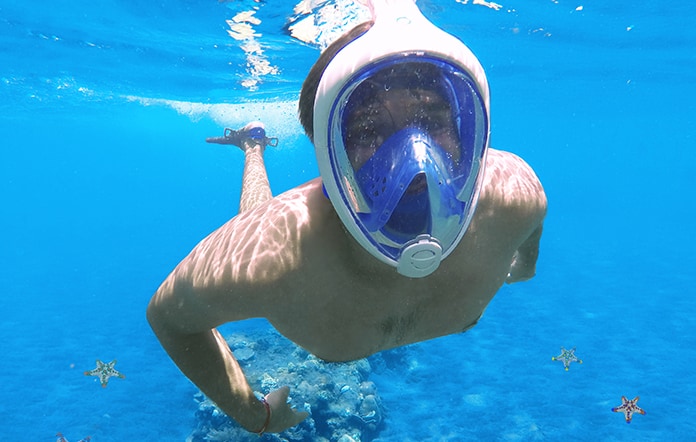
Snorkeling has grown in popularity a lot over the years and has quickly become one of the most popular vacation activities. Those who have been snorkeling in the past know that it was once a sport with a snorkel and a face mask as two separate units. A thing of the past, you will now find full-face masks growing in popularity.
The beauty of the full-face snorkeling mask (FFSM) is that it delivers a wider 180° field of view and makes for a more natural experience that requires less learning. The FFSM allows the user to breathe naturally within the mask without the need to hold a mouthpiece in their mouth. As this design is relatively new, it is important to search for the best full-face snorkel mask for you, to ensure you get the best fit and the best performance.
There are many options on the market, so we have created a list of the best full-face snorkeling masks out there. These full-face snorkel mask reviews will help you weed through the competition and make sure you have a top-of-the-line snorkel mask in 2023!
OUR TOP PICK
WildHorn Seaview V2
- Stand Out Features - Why We Love It
- Anti-fog lens
- Flowtech advanced air intake system
- 20% larger viewing area to give maximum visibility
Anti-fog: Yes
Field of view: 180 degrees
EDITORS CHOICE
HEAD Sport Sea Vision
- Stand Out Features - Why We Love It
- The dry snorkel prevents water from entering the mask and snorkel.
- Has a shatterproof polycarbonate design.
- Tested to medical standards
Anti-fog: Yes
Field of view: 180 degrees
BEST VALUE
OUSPT Full Face Snorkel Mask
- Stand Out Features - Why We Love It
- 180° view
- Natural curve mimics the face
- Medical grade silicone
Anti-fog: Yes
Field of view: 180 degrees
Vaincre 180°
- Stand Out Features - Why We Love It
- Youth-friendly
- Dry snorkel system
- Anti-fog
Anti-fog: Yes
Field of view: 180 degrees
DIVELUX Original
- Stand Out Features - Why We Love It
- Excellent construction
- Hypoallergenic
- Universal protective phone case
Anti-fog: Yes
Field of view: 180 degrees
- Stand Out Features - Why We Love It
- Replacement seals
- Earplugs included
- Satisfaction guaranteed or your money back
Anti-fog: Yes
Field of view: 180 degree
- Stand Out Features - Why We Love It
- High-quality materials
- Self-purging valve
- Anti-fog lenses
Anti-fog: Yes
Field of view: 180 degrees
- Stand Out Features - Why We Love It
- High-quality lens
- Sizing for every face
- Fits children and adults
Anti-fog: Yes
Field of view: 180 degrees
- Stand Out Features - Why We Love It
- 3 sizes
- Tested for safety
- Quick-release
Anti-fog: Yes
Field of view: 180 degrees
- Stand Out Features - Why We Love It
- Protective Carrying Bag
- Go pro mount
- Fits adults and youth
Anti-fog: Yes
Field of view: 180 degrees
How To Choose The Best Full Face Snorkel Mask – Buying Guide
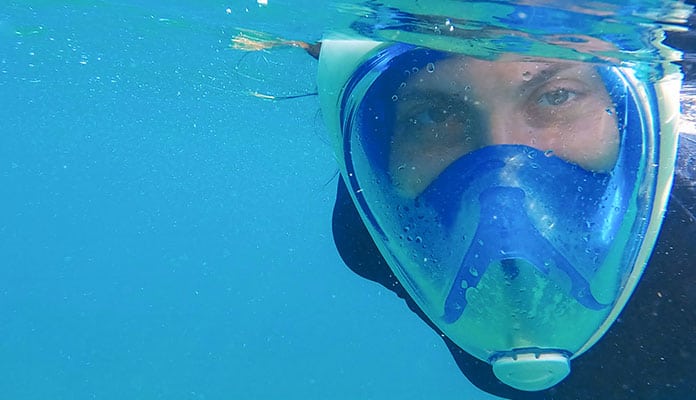
Full face masks are quite a new product to the snorkeling game and therefore a lot less is known about them. While they provide a truly unique snorkeling experience, you will want to ensure that you choose the top-rated full-face snorkel mask for you. This all starts with the fit of the mask.
Mask Fit
Just as with a regular snorkeling mask, the rubber seal that makes contact with your face is called the skirt. This part of the mask is intended to create a watertight seal allowing your mask to stay free from water. Not only will an improper fit cause your snorkel mask to be uncomfortable but it will also cause leaking. An improper fit will require you to constantly clear the water away from your mask, a task that is a lot harder when wearing the best full snorkel mask. Not a task that can be done underwater, you must resurface and lift your head completely out of the water before allowing the water to drain.
Not only will you risk your mask leaking, but an improperly fitting mask can also cause your mask to fog up consistently. This will impair your visibility when underwater and make your experience far less enjoyable. Measuring your face is a good place to start in ensuring that you get an ideal-fitting mask. Specifically, you will want to measure the width of your face and the distance between your eyes. Most FFSM will also want the distance from the top of your nose to the point of your chin.
Whenever possible, we recommend trying on a mask before purchasing. To test for a proper fit, pull the strap to the top of the mask. Tilt your head up to the ceiling and put the mask against your face without putting the strap behind you. Block the snorkel, push the mask towards your face and take an inhaled breath so it suctions to your face. Then, lift your head to a normal position and see if there is any air leakage through your mask. If air can get through, so can water.
If you can look in a mirror, check to see how the mask is fitting your face. Make sure your eyes aren’t cut off by the skirt. If all seems well, then you have found yourself a properly fitted mask.
Comfort
Snorkeling is intended to be a fun experience. Having a comfortably fitting snorkel mask is the best way to ensure that you get the most from your time underwater. To ensure your mask sits comfortably, be sure to check that the skirt fits comfortably around your face lying flat. You do not want to have your eyes cut off from the skirt to restrict your views and impair your water-tight seal.
Oftentimes, ensuring that your snorkel mask is not secured too loosely or tight when wearing it will cause an increase in comfort. Many people think a leaky mask can be fixed by simply tightening your straps. This is not the case, in fact sometimes loosening your mask will fix the problem.
You will want to make sure that you can easily breathe through the mask. It will be a weird feeling breathing through a full-face snorkel mask so it is best to get used to the idea. These mask types are often easier for beginners to get used to as they allow you to breathe normally.
Lens Quality
Not all masks are made evenly which is specifically true about the types of lenses. Nearly every company has the same features but names them differently. With that being said, your lens should have some features regardless of what they name them.
Anti-fog technology is one of these key features. It is quite hard to make a lens that doesn’t fog. Companies have tried a spray-on film, technology built into the lens, and even unique lens materials. Regardless, the mask you decide on should have some technology that helps keep its glass fogless.
You should also consider a lens that has an anti-scratch coating as well. This will go a long way in increasing not only the mask’s durability but also its lifespan. A lot of masks without this feature don’t end their lifespan. Instead, their lens becomes so scratched that the diver can’t see anything through it.
Related Review: Color Correction Scuba Masks
Skirt
Paying attention to the fit of the skirt is important but be sure to also check the material used for your skirt. The type that a mask uses is typically directly related to the mask’s quality. Cheaper masks are typically made from plastics or rubbers. This skirt material has many faults including a short lifespan. This is due to the material being less durable and becoming brittle and cracking with time.
A far superior option is a mask that has a silicone skirt. These masks are far more comfortable and provide a superior seal over their competitor. The silicone used to make the skirts are far thinner than ever before which makes them much more comfortable. Many now contain additives that protect from UV rays which will greatly increase their lifespan.
High-quality full-face snorkel masks are now being made with a secondary skirt. This double layer system reinforces the seal and further prevents the possibility of your mask leaking. When your face moves the second layer does a better job of moving with your skin. It’s essentially a backup seal.
Pro Tip: you may want to shave your beard the day before your snorkel adventure to help provide the best seal. An unclean shave will oftentimes result in your mask leaking.
Straps and Buckles
The straps of your mask should be quite wide. This will help to make the mask much more comfortable to wear and will also make it last much longer. This is especially important for those with long hair as you will not face the dreaded mess of your hair getting tangled in your straps. The stretch and flexibility of your buckle should not be ignored. Wider straps tend to hold their form better meaning they won’t stretch out and end up lasting you longer.
Try your strap on. This should be easy to adjust and not slip when putting on. You should also have lots of room on either side to make it tighter and looser. This feature typically distinguishes between cheap and quality full-face snorkel masks. Masks that are of a higher quality typically come with an incredibly desirable push release to make taking the mask off even easier.
Caring for your mask
Whichever mask you end up choosing, you will want to ensure that you know how to properly care for it. Full Face Snorkel Masks are not very high maintenance so a little bit of TLC will go a long way. You will want to clean your mask at the end of every snorkel day. While this may seem tedious when you are using your mask several days in a row, it can go a long way to ensuring that your mask has a long lifespan. This, in turn, saves you money which should be quite enticing motivation.
Cleaning your mask is especially important if you are wearing any sunscreen during your snorkels. These harsh chemicals don’t react well with the silicone skirts and can lead it to harden your seal which will lead it to crack and leak.
These masks are generally quite fragile so ensuring that you clean your mask carefully and properly will help it to stay scratch-free. Using a cloth designed for lenses is your best bet to keep your mask free of scratches. Cotton works well for this as well. Be sure to always use gentle soapy cleansers diluted with water, or you can use toothpaste.
For those that plan to travel lots with their snorkel masks, paying close attention to how you pack your mask is important. Full-face snorkel masks aren’t ideal for travel as they are quite bulky. When transporting your mask, be sure to transport it in a separate carry bag that will protect it from scratches. You can even throw your mask in a pillowcase to keep it from being scratched by your other gear. Most snorkel masks come with a carry case included, but this is a good option if yours doesn’t.
What To Look For In A Full Face Snorkel Mask
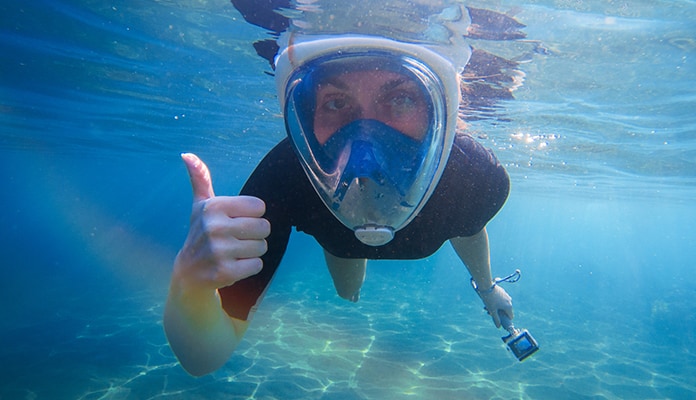
There are many features that you should be aware of before purchasing your mask. It is more complex than going into a store and holding a mask to your face.
Depth
Full-face snorkels are great for coasting along the top of the water. You will be able to see all of the fish and coral, maybe even a shipwreck. But these masks aren’t made for deep diving. When you dive deep, more than 10 feet, you need to regulate your ears. This involves plugging and gently breathing through your nose. Since you don’t have access to your nose you will have to go to one of the other methods such as wiggling your jaw, swallowing, and yawning.
Size
Every full-sized mask should come with size. There is no one-size-fits-all when it comes to masks. If you are curious about what size you measure your face and compare it to the sizing chart for the mask. This is one of the most important things you can do when looking to purchase a mask. If it is too big it can let water in and if it’s too small it can cut off your vision.
Vision
If you are a glasses wearer you will need to wear contacts when diving with a full face snorkel mask. There is not enough room to wear your glasses and can be dangerous if you try. Also, keep in mind that only a few masks can have a prescription lens in the mask.
Use
Full Face Snorkel masks are not designed for full-out exertion. They are made specifically for floating and casual swimming. They have purge valves that let a certain amount of oxygen into the mask and if you are breathing heavily you could be using oxygen faster than it can replenish it. The mask will also heat up as your breathing will be warmer when you are exercising which can make it uncomfortable for long swims.
Fog
If you have ever been snorkeling or scuba diving you have encountered the dreaded fog issue. Without treatment almost every mask will have a layer of condensation build-up on the inside, rendering you unable to see anything. Face snorkel masks are better, but not perfect, in this department. They have a much higher chance of not fogging as there is constant airflow. We recommend trying the mask for a short swim to see if you have a mask that fogs. There are easy ways to remedy a fogging mask which include spit, toothpaste, and dish soap.
You might also be interested in:
Scuba Masks & Full Face Scuba Masks
Perfect Prescription Snorkel Mask
Field of view
Many people are raving about how much more you can see with a full-face snorkel. Instead of a small field of view through the typical mask, you can see a complete 180 degrees. Some people will love this while others won’t. The sides of the mask are larger than typical masks which can restrict part of your peripheral vision. It is completely the user’s opinion when it comes to this feature.
Wave guard
Nobody wants to drink ocean water when they’re snorkeling. Wave guards prevent this from happening. These are essentially little flaps that close when a wave overtakes you preventing water from rushing into the snorkel. It is highly recommended to purchase masks with this feature as it will make your days on the water much more enjoyable.
FAQs
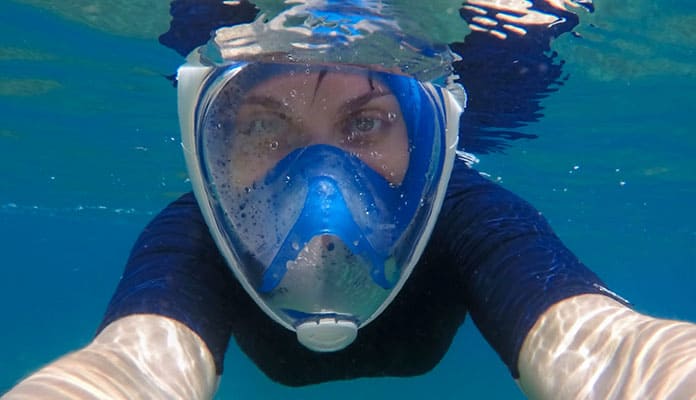
Q: How Do Full Face Snorkel Masks Work?
A: Full-face snorkel masks are an engineering feat. Not only do they allow you to breathe without holding a snorkel in your mouth, but also have a much wider field of view. As you breathe in and out the air circulates throughout the mask. Most of these snorkels have a dual airflow system that quickly gets rid of your out-breath. All of the moisture is forced out of the mask which ensures you only get a fresh breath of air every time, but also makes sure your mask doesn’t fog.
Q: Which Full Face Snorkel Mask Is The Best?
A: This is a question that can be hard to decide as a lot of it relies on personal preference. Instead of looking for certain brands, we suggest looking for features. The way to tell a high-quality mask is by what the manufacturer says about it. A few necessary features are anti-fogging, air circulation, a one-way valve for the snorkel, and the seal around your face.
If your mask fogs up while you’re using it you won’t be able to see anything which ultimately wastes your time and money. A full-face mask needs excellent air circulation. The last thing you want while your face is underwater is to not be able to breathe. Also, if your snorkel doesn’t have a one-way valve you could get water in your snorkel. This is a feature that every mask should come with – just ensure your mask speaks about it in the write-up. Lastly, the seal around your face should be made of a flexible, comfortable material. This is usually seen in organic, hypoallergenic silicone. It is flexible and creates an excellent seal around your face which keeps water out.
Q: How To Wear A Full Face Snorkel Mask?
A: Full face designs are relatively easy to wear. The edge of the full-face snorkel goes around your eyes and encapsulates your nose and mouth. The snorkel should be pointed up so that it sits above the water. The strap should sit comfortably around the back of your head. It shouldn’t be too tight or cut into your head, but also shouldn’t be loose or flopping around.
Q: Can I Have A Beard With A Full Face Snorkel Mask?
A: This can be a tricky question. The short answer is no, but there are exceptions. The seal needs a clean smooth surface to bond with. A beard can get in the way of this and can make the mask leak water. If you have short stubble you may get away with it, but you run the risk of the seal breaking while you’re swimming.
Q: Can I Freedive With The Full Face Snorkel Mask?
A: Freediving with a full-face snorkel mask is strongly not recommended. They are designed to not be fully submerged in water. Since the mask has a full piece of glass over your entire face you will not be able to equalize as you descend. This is when you release the pressure from the water by gently plugging your nose and exhaling through it. Since you cannot equalize you can cause significant damage to your eardrums as you descend. You can use a nose plug to achieve this but even still, a full face snorkel mask is not the best snorkel mask to free dive with. We recommend a more traditional mask for this.
Related Review: Freediving Masks
Q: How Can I Properly Care For My Full Face Snorkel Mask?
A: Most snorkel masks come with a cleaner. If you are diving in the ocean you should rinse your mask in freshwater and ensure that there is no salt water left on the mask. This can eat away at the integral parts like the one-way valve and the seal. If you are swimming in particularly dirty water you should ensure that there is no debris, such as sand or seaweed, stuck to your mask before you store it. Also, let it dry before you put it in the storage bag. This will ensure that it lasts for the most amount of time and doesn’t promote bacteria to grow on it. You can use a glass cleaner to clean the inside of the mask so you are ready to simply pull it out of the bag and throw it on for your next trip.
Q: Are Full Face Snorkel Masks Safe?
A: Sadly, there is no clear answer to this question. There have been investigations into the safety of FFSM in different parts of the world. Two primary factors have been raised. First, a poorly designed face mask might allow a buildup of CO2. Some manufacturers, however not all, have taken these concerns to heart and have their products tested by outside labs. In some cases redesigned to provide a safer product. A second concern is that in case the mask is flooded or the breathing tube is blocked, the suction can make the mask difficult to remove. A quick-release buckle will help solve this problem as well as some practice removing the mask before you use it. If you are planning on using an FFSM on vacation, check first with a local tour operator if they are allowed. Some tour operators have banned them from their tours or only allow certain brands.
Who are these full-face snorkel masks for?
If you are learning how to snorkel or are trying to get comfortable with your face in the water then the best snorkel mask is perfect for you. Beginners will love not having to get used to breathing through your mouth and trusting a piece of plastic for their breath. People who have been snorkeling before and get a sore jaw from constantly holding onto the full-face snorkel can benefit from this style of mask. Something to keep in mind though is using a beard. Beards can have an unwanted effect on your mask. The hair can break the bond the mask should have with your face. Instead of sealing directly to your skin your beard will get in the way and let water in, rendering the mask useless. Some stubble is fine but anything longer than a three-day growth can have negative effects on your snorkeling.
Globo Surf Overview
A perfectly fitted full-face snorkel mask can make your day on the water that much better. All of these masks give you a perfect 180-degree field of view with a fog-free lens. Look for features like wave guards and bonuses like earplugs and travel cases. No longer do you have to struggle to keep your snorkel in your mouth. Simply strap this mask on and you are ready for your adventure on the water. Get ready to experience beach life with the best full mask snorkel.
Have you ever tried a full face snorkel mask? Let us know what you thought of it in the comment section below.



